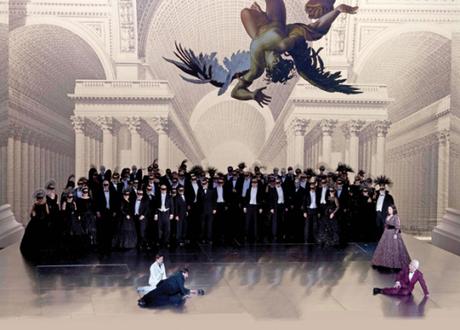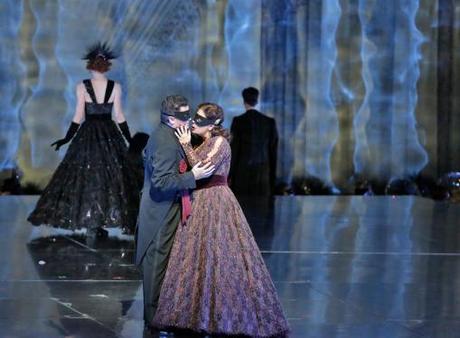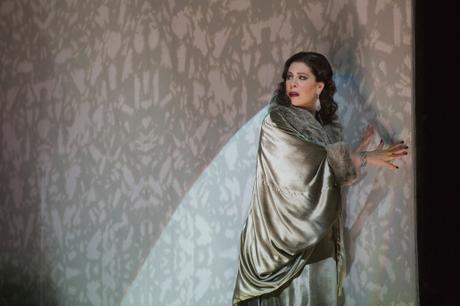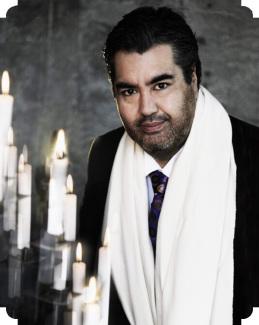 Gustavo’s death scene, Act III, of Verdi’s Un Ballo in Maschera (Beth Bergman)
Gustavo’s death scene, Act III, of Verdi’s Un Ballo in Maschera (Beth Bergman)Lost in Translation
When last we left the Metropolitan Opera radio season, which for me culminated on May 2 with the broadcast of Verdi’s Un Ballo in Maschera (“A Masked Ball”), the company had to face yet another of those infuriatingly abrupt cast substitutions. While the April 24th revival of its controversial David Alden production of Ballo had been headlined by the strikingly stylish Piotr Beczala as Gustavo, the Saturday transmission a week later brought Brazilian tenor Ricardo Tamura back to the airwaves. Yes, dear friends, Mr. Beczala took sick and our stalwart champion of lost causes, Senhor Tamura, stepped in once again to enter the fray and save the day.
Tamura’s earlier understudy of Don Carlo in the opera of the same name, reviewed here on August 1 (see the following link: https://josmarlopes.wordpress.com/2015/08/01/is-there-a-doctor-in-the-opera-house-don-carlo-un-ballo-in-maschera-and-the-mets-cover-crisis/), was not, to put it bluntly, the “big break” one might have expected given the eleventh-hour nature of the circumstances. However, as indicated in my initial post, I determined to give Tamura another shot at shining in a part that would showcase his not inconsiderable talents.
With that out of the way, let’s say that the odds were stacked against him. Trying to follow in Beczala’s footsteps is, by any rationale, an act of bravery if not downright lunacy. Beczala had received glowing reviews from the press for his lyrically adept portrayal of King Gustav III and his ill-fated passion for Amelia. Drawing comparisons with famed Swedish tenor Jussi Bjoerling, one of the Met’s brightest and dearest lights from the 1940s and ‘50s, Beczala superbly transcended director Alden’s sometimes awkward staging, as well as sidestepped the geometrically intricate patterns weaved by set-maker Paul Steinberg, to give a delicately nuanced, emotionally satisfying and vocally thrilling performance. Still, one held out hope that Tamura could hold his own against the competition.
Before I get to the singing, I have a few words to say about the staging: this was one more in a long line of tiresome modern reconfigurations that have enveloped the Met Opera world of late. Mind you, I am not opposed to innovation for innovation’s sake, nor am I adverse to a strict traditionalist viewpoint either. I do like to see some thought behind a director’s concept. I also like for directors and producers to provide a clearer focus and motivational impetus for why they are interpreting a piece in the way they are interpreting it. That’s not too much to ask for, is it?

But in this production, we’ll need to take the good with the bad. And there were plenty of good things in it to soothe the most savage of beasts in all of us. I was particularly taken by a massive painting of the mythological figure Icarus, which loomed large over each of the succeeding acts as this production’s main motif: Gustavo, whose devil-may-care frivolity gets him into all kinds of illicit activity, skirts too close to the sun for comfort. He gets knocked down. Well, let’s just spell it out, shall we: Gustavo is killed for taking one too many liberties with his best friend’s wife, the lovely Amelia. His chief advisor, Count Anckarström, who happens to be married to Amelia, swears vengeance on the king by conspiring with the plotters Horn and Ribbing to assassinate him at a masked ball.
Wow! Talk about jealously, that’s basically the plot of Verdi’s penultimate masterpiece Otello, with a few modulations of course. And the music of Un Ballo in Maschera constantly reflects that coming storm of a work, as well as the tempest that permeates the grand opera Don Carlo. For instance, take the last scene of Ballo, where the courtiers are dressed all in black, their faces covered by matching black masks, surely one of the most potent examples of operatic irony that Verdi was capable of conceiving. Count Anckarström stands out by virtue of his purplish outfit, purple being the color of royalty or nobility, therefore “ironic” in the sense that the fellow with the “noblest” of intentions is the one who murders his king.
As the dying monarch gasps out his last words (“Addio, miei figli” — “Farewell, my children”), forgiving those who perpetrated the crime upon his person, the violins have played a mournful theme high up in the strings’ register which alert listeners might find reminiscent of Rodrigo’s air, “O Carlo, ascolta,” in his death scene from Don Carlo. The prevailingly black, white and gray color scheme (by costume designer Brigitte Reiffenstuel) all-but washes out any sense of vibrancy. Ah, but that vibrancy comes chiefly from the singing, which on this occasion mostly lived up to the previous standard set when this production was new.
Something to Rave About

The chief architects of this revival were, in order of vocal excellence, baritone Dmitri Hvorostovsky as the Count, soprano Sondra Radvanovsky as his wife Amelia, soprano Heidi Stober as the page Oscar, mezzo-soprano Dolora Zajick as the sorceress Ulrica, basses David Crawford and Keith Miller as the conspirators Horn and Ribbing, baritone Trevor Scheunemann as the sailor Cristiano (or Silvano in the so-called “Boston” setting of the piece), and tenor Mark Schowalter as the Judge. The conductor on this occasion was the returning James Levine, always a commanding presence on the podium.
All were fine, with particular praise going to Hvorostovsky’s “Eri tu?” from Act III, his long-lined legato phrasing lovingly displayed in a riveting, tour de force performance unequalled in strength and breath control; and, of course, to the belle of the masked ball, the stunning Ms. Radvanovsky, whose pristine “Morrò ma prima in grazia,” her heartbreaking farewell to her little son, moved the audience to cheers and shouts of “brava, diva.” Now there was something to rave about!
Maestro Levine surely loves this score as much as anything else in Verdi, although his tentative touches in the opera’s introduction slowly but surely caught up with the rest of his exemplary paced output later on. Heidi Stober’s tomboyish Oscar (in top hat and cane, of all things!) and Dolora Zajick’s voluminous Ulrica filled out their roles to perfection, as did the sinister duo of Crawford and Miller as the booming bassos of the piece.
As for Tamura’s spur-of-the-moment contribution, let’s say that Pavarotti he is not. Beczala he is not. Not even Marcelo Álvarez, who brought a wonderfully crisp, bel canto-esque elegance to Gustavo at this production’s premiere. Tamura, at this early stage in his career, for better or for worse, is a pleasant, workmanlike artist who gives his all, albeit one who has yet to develop a distinct vocal personality, or a definable stamp of presenting a dynamic characterization of one of opera’s most individually multihued personae.
Time and experience, along with constant exposure to artists of the caliber of those mentioned above, will likely alter and shape Tamura’s view of this and other Verdi parts into a transformative whole.

Tamura did gain in strength and confidence as the opera progressed, even though he ducked the optional high C at the conclusion of his Act II love duet with Amelia (to be fair, though, most tenors tend to bypass the top note, one that Verdi never wrote but that tradition dictates be taken anyway). By the time he got to his show-stopping last act aria, “Ma se me forza perderti,” Tamura even managed to kindle some tenderness and involvement in the drama.
You may have noticed that I am being hesitant in negatively criticizing the tenor in my typically “forthright” manner. Again, I must emphasize that Ricardo Tamura was literally shoved onto the spotlight as a surrogate performer, and for the second time on radio and on short notice. The other participants are all veterans of this production, ergo they’ve each had sufficient rehearsal time to find their marks and ease into their characters — much more so than the lead.
I am giving the devil his due here, and allowing for extenuating circumstances to temper my feelings about an obviously gifted performer, one with a promising future in opera. It’s not every day that young artists can be heard nationally (or internationally) over the public airwaves. Consequently, it is my fervent wish that Tamura will take full advantage of the opportunity awarded him — one less fortunate singers would give their right arms for.
Copyright © 2015 by Josmar F. Lopes

